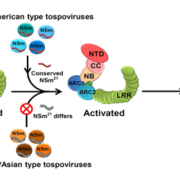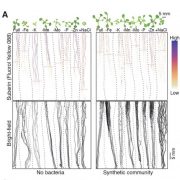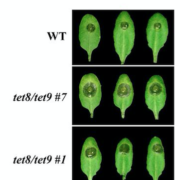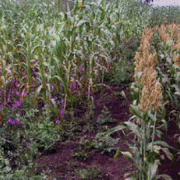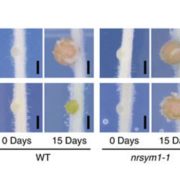Review: The exocyst complex is targeted by pathogen effectors
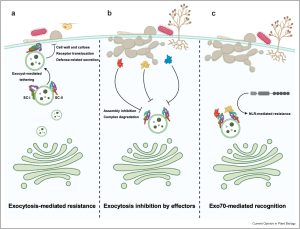 The exocyst complex is a conserved octameric protein complex in eukaryotic cells. Its primary function is to tether secretory vesicles to the plasma membrane during the exocytosis process, and it is also involved in autophagy and host-pathogen interactions. Intriguingly, EXO70, one of the subunits of the exocyst complex, is present in a single copy in animals and fungi, but has expanded into a large protein family in plants. In a recent review, De la Concepcion brings together current research about the exocyst complex, including its 3D structure and investigations into the functional diversification of EXO70 in plants. Most notably, the review focuses on the different ways that the exocyst complex helps plants combat pathogens, for example through direct or indirect interactions with immune proteins. Not surprisingly given its role in immunity, the exocyst complex is targeted by several pathogen effectors, which are summarized in a useful table listing pathogen effectors and their targeted exocyst subunits. The review ends by raising open important questions about the diversification of exocyst subunits and pathogen effector–exocyst interactions. (Summary by Xiaohui Li @Xiao_hui_Li) Curr. Opin. Plant Biol. 10.1016/j.pbi.2023.102482. (For further insights into the exocyst complex’s role in autophagy, refer to Viktor Žárský’s detailed review in FEBS Letters 10.1002/1873-3468.14430.)
The exocyst complex is a conserved octameric protein complex in eukaryotic cells. Its primary function is to tether secretory vesicles to the plasma membrane during the exocytosis process, and it is also involved in autophagy and host-pathogen interactions. Intriguingly, EXO70, one of the subunits of the exocyst complex, is present in a single copy in animals and fungi, but has expanded into a large protein family in plants. In a recent review, De la Concepcion brings together current research about the exocyst complex, including its 3D structure and investigations into the functional diversification of EXO70 in plants. Most notably, the review focuses on the different ways that the exocyst complex helps plants combat pathogens, for example through direct or indirect interactions with immune proteins. Not surprisingly given its role in immunity, the exocyst complex is targeted by several pathogen effectors, which are summarized in a useful table listing pathogen effectors and their targeted exocyst subunits. The review ends by raising open important questions about the diversification of exocyst subunits and pathogen effector–exocyst interactions. (Summary by Xiaohui Li @Xiao_hui_Li) Curr. Opin. Plant Biol. 10.1016/j.pbi.2023.102482. (For further insights into the exocyst complex’s role in autophagy, refer to Viktor Žárský’s detailed review in FEBS Letters 10.1002/1873-3468.14430.)



